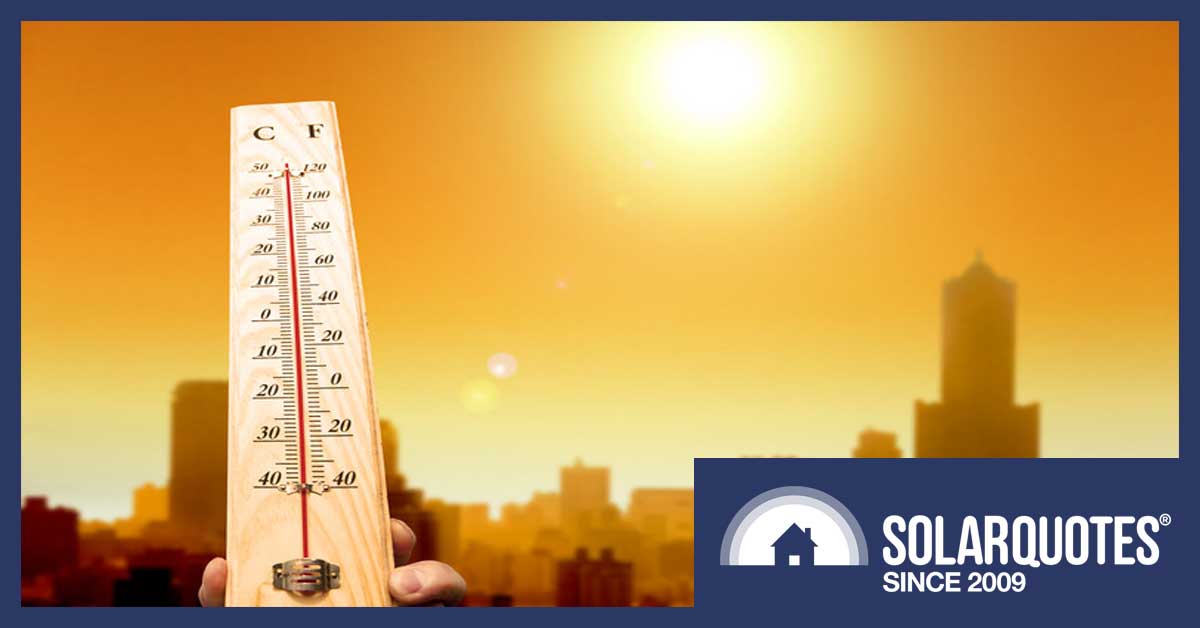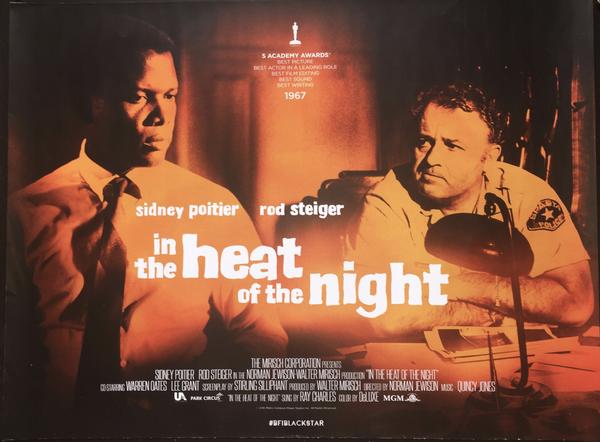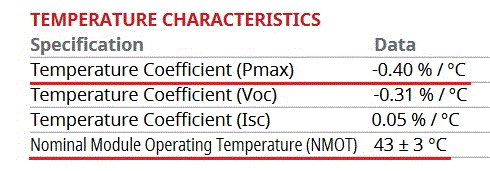
Solar panel output reduces (slightly) as the temperature rises.
It’s an unfortunate fact the hotter it gets the worse solar panels perform. As fossil fuel generators can suffer even greater efficiency loss due to heat, this is nothing to get all steamed up about. But it’s still not a good thing.
When deciding what solar panels to get — if all else is equal — it pays to choose the one that suffers the least efficiency loss due to heat. The hard part is knowing how to compare them. This requires two values you can find on most solar panel datasheets:
- Temperature coefficient of Pmax, and…
- NOCT
I’m going to explain the meaning of these terms and how you can use them to work out which solar panels are best at handling heat. I’ll also include a ranked list of modules and if you’re lucky the ones you want to compare will be on that.
What Is Pmax?
The temperature coefficient of Pmax, or just Pmax for short, is how much a solar panel’s efficiency is reduced by for each degree increase in the panel’s temperature.
Don’t make this newbie mistake: For the Pmax calculation you must use the temperature of the solar panel – not the ambient air temperature.
Pmax is expressed as a negative percentage and a typical value is -0.4%. This is how much a solar panel’s efficiency decreases for each degree its temperature is above 25 degrees.
If a solar panel has the following characteristics:
- A temperature coefficient of Pmax of -0.4%
- A temperature of 45 degrees.
We can work out its efficiency loss from heat by working out how many degrees it is above 25:
- 45 degrees – 25 degrees = 20 degrees
And then multiplying that by its Pmax of -0.4%:
- 20 * -0.4% = -8%
This gives an 8% efficiency loss. By subtracting that 8% loss from 100% we can know the module will only provide 92% as much power as it would if it was at 25 degrees. If the solar panel provides 300 watts when its temperature is 25 degrees, under otherwise identical conditions, it will only provide 276 watts when its temperature is 45 degrees.
Most solar panels rarely go above 65 degrees even in a heatwave, so if a panel’s Pmax is -0.4% you can generally expect it to almost always provide at least 84% as much power as it would if its temperature was only 25 degrees.
A panel’s efficiency can improve if its temperature drops below 25 degrees, but the rate it increases will decline as it gets colder.

But not solar panels.
What Is NOCT?
NOCT stands for Nominal Operating Cell Temperature. It can also be called NMOT or Nominal Module Operating Temperature. NOCT is the temperature a panel’s solar cells will be at under the following specific conditions:
- The solar panel is receiving sunlight at an intensity of 800 watts per square meter.
- The air temperature is 20 degrees.
- The wind is blowing at 1m per second — which is so slow it doesn’t even count as a light breeze.
- The back of the module is exposed to the open air.
A typical NOCT value for a panel is 45 degrees Celsius. The lower it is the better because it means the panel will be cooler when sitting in the sun. Typically this value will have a margin of error such as 45 +/- 3 degrees. This means there is a 68% chance the NOCT of the solar panel will be between 42 and 48 degrees. This is a considerable amount of variation, but if you have 20+ modules there is a good chance it will even out to around 45 degrees on average.
Most solar panel datasheets will tell you what their NOCT is, but some such as SunPower’s, keep it a secret.

If you installed solar panels, the roof wouldn’t get so hot. And you could afford to run the air conditioner.
Example: Jinko Eagle PERC 60M Vs. Candian CS6K
To compare two panels you first need to look up their Pmax and NOCT values on their datasheets. You can find the datasheets on the manufacturers’ websites. You can also download many from the SolarQuotes solar panel comparison table.
As an example, I’ll compare a Jinko Solar Eagle PERC 60M panel with a Canadian Solar CS6K panel. The values on the Jinko module’s datasheet are shown below underlined in red:
And here’s the same information for the Canadian Solar module:
Ignoring the margins of error for the NOCT values, comparing these figures gives:
- Pmax: Jinko -0.37% versus Canadian -0.40%
- NOCT: Jinko 45 degrees versus Canadian 43 degrees.
So the Jinko panel is ahead on Pmax while the Canadian panel is ahead on NOCT. To determine which suffers the least loss in efficiency due to heat we look at how much their NOCT is above 25 degrees and multiply that by their Pmax. This gives us:
- Jinko: -7.4%
- Canadian: -7.2%
If we add those negative values to 100% we can say that compared to solar panels at a temperature of 25 degrees:
- The Jinko panel will provide 92.6% as much power under NOCT conditions.
- The Canadian panel will provide 92.8% as much power under NOCT conditions.
So despite having a worse Pmax value, the Canadian Solar module suffers just a little less efficiency loss from heat than the Jinko one.

It doesn’t matter how hot it is at night. That’s not going to affect your solar output.
List Of Solar Panel Efficiencies Under NOCT Conditions
I know that some of you dread having to do maths almost as much as I dread having to act like a normal human being so I’ve made a list of the efficiency of a number of different panels under NOCT conditions from the best to the worst, showing the percentage of power output they will provide under NOCT conditions compared to if — all else equal — they were at 25 degrees. It is possible the solar panels you want to compare will be among the list and will save you some time:
- Panasonic HIT N320K: 95.1%
- LG Solar LG330N1C: 93.9%
- Canadian Solar KuPower CS3K: 93.7%
- QCELLS Q.PEAK DUO-G5: 93.5%
- Suntech HyPro: 93.4%
- Trina Honey PD05: 93.4%
- REC TWINPEAK 2: 92.9%
- Canadian CS6K: 92.8%
- Jinko Cheetah 60M PERC: 92.6%
- Jinko Eagle PERC 60M: 92.6%
- Longi LR6 60PE PERC: 92.6%
- JA Solar JAM60S01: 92.4%
- Winaico WXP MX PERC: 92.3%
- CSUN 60M: 92.2%
- HT-SAAE HT60-156M: 92.2%
- Hyundai HiA-S300RG: 91.8%
- Longi LR6 60DG Mono: 91.8%
- Suntech STP 280: 91.8%
- Tindo Karra PERC: 91.8%
We all pay when clean solar energy output is reduced. It results in greater global warming, which is the biggest heat of them all.1
Total Energy Production
The best performing solar panel on the list is the LG Solar LG330N1C.2 Its efficiency under NOCT conditions is 93.9%. This is 2.3% more than the two modules at the bottom of the list. You may be wondering does this means the LG Solar panel would produce around 2.3% more energy per watt of module capacity than the Hyundai or Tindo solar panels? I would say — for the most part — yes. While it might be a little less than 2.3% I would expect it to be close. This is because heat is always going to be an issue for solar panels in Australia and the periods in which they produce most of their output are periods they are exposed to enough sunlight to significantly raise their temperature. This means it can definitely be worth your while to choose a solar panel that handles heat better.




 RSS - Posts
RSS - Posts



I’m starting to worry about the material my panel’s nuts and bolts are made of now !
I appreciate all this data is well researched Ronald (kudos to you) and maybe useful to some who worry about such differences but in the scheme of things aren’t we worrying about the extra millisecond to boot into Windows from one CPU to another that the computer geeks get excited about ? My inverter for example annoyingly and, fortunately only occasionally, disconnects itself from the battery resulting in the battery self-protection switching the battery off and me paying for the power in the evenings for several days before I realise and reset it. That probably amounts to more money lost (spent) out of my pocket over twelve months than I would forfeit over such a small difference between the NOCT in panels ? Heck even keeping a Hyundai panel clean on a regular basis would probably save more than using a dirty LG !
That’s a fair cop. I probably should have included a warning that this article is for the anally retentive*.
*The term anal retentive (also anally retentive), often abbreviated to anal, is used to describe a person who pays such attention to detail that it becomes an obsession and may be an annoyance to others, potentially to the detriment of the anal-retentive person. The term derives from Freudian psychoanalysis.
— Wikipedia
Great article. But what about SunPower?
Good question! They have the temperature coefficient of Pmax on their datasheets but not their NOCT. The Pmax of their X-Series panels is -0.29% which is excellent and their E-Series is -0.35%. For their P-Series it is -0.37%.
The next step of course is to see whether the 2% extra energy output is worth the difference in price between different panels, which is often considerably more than 2%. Or is it just easier to put one more cheaper panel on the roof to cover the slightly lower efficiency.
Of course where roof real estate is precious, then use it wisely.
these numbers are all related to silicon physical properties,we can’t fix that.
thin film panels,albeit less efficient have much better high temperature behaviour.
for example solar frontier SF170 has a NOCT of 47degrC and Pmax tempco of -0.31%/K.(K=Kelvin).
Beside using a PV with better temp. performance
We can do other ways to minimize the temperature issues
1 Always use a bigger watt panel for a given sys size
Example a nomal 5 kw will require only 15 to 16 panels NOT 18 or 19
so having less PV , we can have more space between the rows of PV
this assist heat disappation from under panels & maintenance works
2 Use railing that give a bigger gap under the panels , create a better air flow , The 2 railings as I know are the Radiant and the Nova of Hopergy that offer better The rail sit on top of the roof bracket instead of at the side
If I understood this right, your conclusion should be “So despite having a worse Pmax value, the Canadian Solar module suffers just a little less efficiency loss from heat than the Jinko one” at NOCT conditions.
And those conclusions are for NOCT, meaning air temperature is 20ºC. Often, air temperature will be much higher and so, there will be a threshold above which Jinko will outperform Canadian, in this respect.
If I got this right, the 2 panels perform equally when [T-(43-25)]x(-0.40)=[T-(45-25)]x(-0.37). This gives T=6.67ºC.
This would mean that when the panel’s temperature is above 43+6.7=49.7ºC in the Canadian or 45+6.7=51.7ºC in the Jinko, the Jinko is better than the Canadian, in this respect.
I think solar panels can easily get near 60ºC with hot weather.
A panel with a NOCT of 43 is always going to be a little cooler than a panel with a NOCT of 45 when sunlight is shining on them. A lower NOCT panel will absorb less sunlight as heat than a higher NOCT panel no matter what the air temperature. If there is only a little sunlight falling on them, say it’s early or late in the day, then the temperature difference won’t be much, but there will always be a difference while the sun is up.
“A panel with a NOCT of 43 is always going to be a little cooler than a panel with a NOCT of 45 when sunlight is shining on them.”
Right, but for temperatures above 49.7ºC in the Canadian panel and 51.7ºC in the Jinko panel (the Canadian is still at a lower temp.) the Jinko starts performing better.
If the better temperature coefficient of Pmax of the Jinko didn’t matter at all we would only need to consider the NOCT parameter when choosing the panel. The temperature coefficient of Pmax parameter would be irrelevant.
So, for cold climate the Canadian might be a better choice, but for hot, even mild climate, the Jinko would be better.
Sorry, I see what you are saying now.
One panel could definitely handle heat better or worse overall depending on the location. Very roughly it’s about 15 degrees hotter in Darwin than Hobart but that difference could be enough to give one panel an edge over another but it would be difficult to work out if that’s the case.
Interesting read as always.
What would the LG Solar LG345N1C come in at?
Temperature Characteristics
NMOT 42 ± 3 °C
Pmax -0.36 %/°C
Voc -0.27 %/°C
Isc 0.03 %/°C
Electrical Properties (NMOT3)
Module Type 345 W
Maximum Power Pmax (W) 258
MPP Voltage Vmpp (V) 32.7
MPP Current Impp (A) 7.89
Open Circuit Voltage Voc (V) 38.7
Short Circuit Current Isc (A) 8.50
Is this correct?
42-25= 17
17x-0.36 %= -6.48%
thus 345w x 93.52% = 322.6w @ 42°C (where does Maximum Power Pmax (W) 258 fit in??)
And how does Micro Inverters cope with these higher ‘on roof’ temps versus the string inverters who can reside in the shade?
Thanks
https://www.lgenergy.com.au/uploads/download_files/102520182a69211b7824ff9b608f68c8a8644808.pdf
That’s correct except 17 x -.0.36% = -6.12%. So it would come to 93.9%.
Microinverters are simply made tough. I’d say the necessity of dealing with higher temperatures is a major reason why more companies aren’t making them.
I have Scott panels, how do they perform? Question from female ignoramus: can it help to cool down the panels (Ipswich, often VERY hot) by putting a hose on them?
You would have to have the hose on them all the time when it is hot.
Careful not to put cold water on a very hot glass. The thermal shock might break it.
I definitely agree with what MA said. Cold water on hot panels is not good for them. A sun shower won’t shatter them but sudden thermal contraction still isn’t good for them.
That should be Schott (250 w)
I’m afraid Schott panels perform pretty poorly in the heat according to the figures I found. Their NOCT is 48 degrees and their Pmax is -0.44%. So their output at NOCT would be 89.9% what it would be if all else was equal and they were at 25 degrees. They don’t do well because they are older panels. Also, they’re from Germany where they are probably less concerned about heat. But, from what I’ve heard, they are high quality panels.
Thanks so very much for looking that up Ronald. I guess we just have to be happy with whatever they’re giving us now that they’re there. 🙂
Panasonic has the industry leading temperature coefficient:
https://news.panasonic.com/global/press/data/2017/05/en170524-2/en170524-2.html
https://na.panasonic.com/us/energy-solutions/why-panasonic
Panasonic 320w panels have NOCT of 44C and Pmax of -0.258. At NOCT their efficiency is 95.1%, which beats every other panel that you listed.
That’s news to me. Thanks for pointing it out. I’ve added the Panasonic panel to the list along with a few others that don’t handle the heat quite as well.
On the list of brands of panels that were tested in this article, I noticed that ‘Sunpower’ panels were not included. I am of the understanding that this brand is the ” Roll Royce of panels” and am wondering why they weren’t included in the test.
SunPower didn’t include NOCT on their datasheets. If I can find out their official NOCT I’ll add them to the list.
So would I be better off to installing CSun panels on a white roof rather than a black roof which would add to the panels temperature…..how do CSun rate please ?
Looking at the latest datasheet for the CSUN 60M panels I see it is not great at handling the heat, coming in at 92.2% of its rated output at NOCT, which puts it near the bottom. I have added it to the list.
A white roof would be better than a black roof, but it won’t make much difference to the solar panel temperature. Panels shade the roof they cover, so if the solar system is large enough the roof colour should have little effect on their temperature.
As usual, the Solar Quotes article on Pmax and NOCT is valuable and provides a lot of useful information.
When it comes down to it, the differences among the various panel brands are not particularly significant and need to be considered alongside other parameters. First and foremost, to my mind, is the quality of the panels and their expected life, as reflected in the manufacturer’s warranty period, among other things. If I were a commercial operator setting up a solar electricity farm, I would pay a lot of attention to Pmax and NOCT. On the other hand, as the owner of an installed domestic system (6.4 kWh max 3-phase system, using Jinko panels and a Fronius inverter), these are not factors I am going to get too exercised about.
Keep up the great work, though. We chose our installer and the brand of products to use, using information compiled by Solar Quotes, and I will always be grateful for the help the website gave us in making these tricky choices.
Longi panels how do they compare they don’t seem to get much publicity
Longi’s LR6 60DG Monosilicon panels have an efficiency of 91.8% at NOCT while while their LR6 60PE PERC panels are 92.6%. I have added them to the list.
Thank you much appreciated Still trying to under stand all the pros and cons of Solar Enjoy your updates on what is going on in the industry
A friend installed “genuine (top quality) German panels” in 2013 against my advice*. I am from an engineering background, not solar, so this was not “NOCT based”. Another guy I know from 2010 in outback north NSW had European panels and they proved so useless on hot days he actually changed them via his installer.
Local guy has 9Kw of them on the top of a 2 storey house with no shading and little breeze. I am 50Kms north and have 3Kw of “Oz standard” panels with microinvertors partially shaded in the mid afternoon.
Result – pick any 35+ Celsius day and my 3Kw system generates well over 50% more than his 9Kw until mid afternoon when I lose about 2 panels due to shading. The “9Kw output” is as low as 1Kw on really hot days here.
So I reckon that this stuff matters a lot if someone gets Euro panels, not so much across different Oz standard panels. I also cannot believe that some installs use horizontal rails (i.e. across the top) which must act as a heat trap compared to side rails.
I also feel that roof temps probably exceed 90 Celsius in the West in summer fairly often, not a mere 60 Celsius.
My advice*: I suspected that not only were they way more expensive (over double), they also did not care about heat in Germany. Proven correct twice now.
I am new to living with solar. I am trying to scope out a grid-tied hybrid system with battery back-up and electric car charging built in. I prefer to have installers bid on a system that reflects my preferences rather than theirs. I had discounted specifying an AC coupled system because I felt the conversion(s) back and forth between AC and DC would reduce system efficiency too dramatically.
Reading questions and comments regarding AC panels/systems, above stopped me in my tracks. I am wondering if I may have dismissed AC too quickly.
So far, my ‘system’ is comprised of Panasonic Black HIT N325K 40mm panels, SolarEdge P400 power optimizers, SolarEdge’s StorEdge SE7600A-US single phase inverter, LG Chem RESU10H battery, Energy meter, Auto-transformer and a yet unidentified car charging black box.
What AC coupled components might be specified to provide a similar set of capabilities? Is my concern about AC to DC conversion losses overblown? I have a concrete tile roof, is the 600v DC a significantly higher safety risk than 240v AC? One corner of my panel array will sit almost directly above the location where the inverter / circuit breaker will be located so wiring from the roof will be a very short, vertical drop.
FYI, I live in California (today is107F or 43.6C so my panel temps will get hot in the summer and aesthetically I have a strong preference for the ‘solid’ black look of these panels. I would greatly appreciate hearing yours and your readers thoughts.
First time reader of your web site – I am finding it a wealth of information. Very helpful. Thanks!
I can only give general information since things are significantly different in California than Australia.
First off, don’t worry about the efficiency loss from AC coupled batteries. In practice it makes very little difference.
Correctly installed 600 volt DC is as safe as any other large electrical device. But if you want to be really focused on safety you can use microinverters instead so you won’t have DC cabling on the roof. (The SolarEdge inverter you are considering should be capable of detecting DC arcs and shutting them down.)
You will take a small hit to the efficiency of your solar panels if you get all black ones. So if you don’t care about the color or they will be in a position where no one will see them I’d say don’t bother getting them, but if you like the way they look then go right ahead as it makes very little difference.
I would say install as many south, west and/or east facing panels as you can. It is better to have a larger system than the best panels, but it’s also important to avoid low quality crap panels. Our Solar 101 Guide has a graphic showing all the panels we recommend. I presume most will be available in California:
https://www.solarquotes.com.au/solar101.html
Hi, What is the difference between NOMT and NOCT? Are they the same, as different cells can have different temperatures due to shading within a module?
Secondly, I have seen that even though the NOCT x PMAX is lower for some panels, they have higher output as per NOCT on Data Sheet. One such example was JAM72S30 525-550/MR/1500V the 545W Panel from JA Solar produces 6 Watts more per data sheet from CS Panels